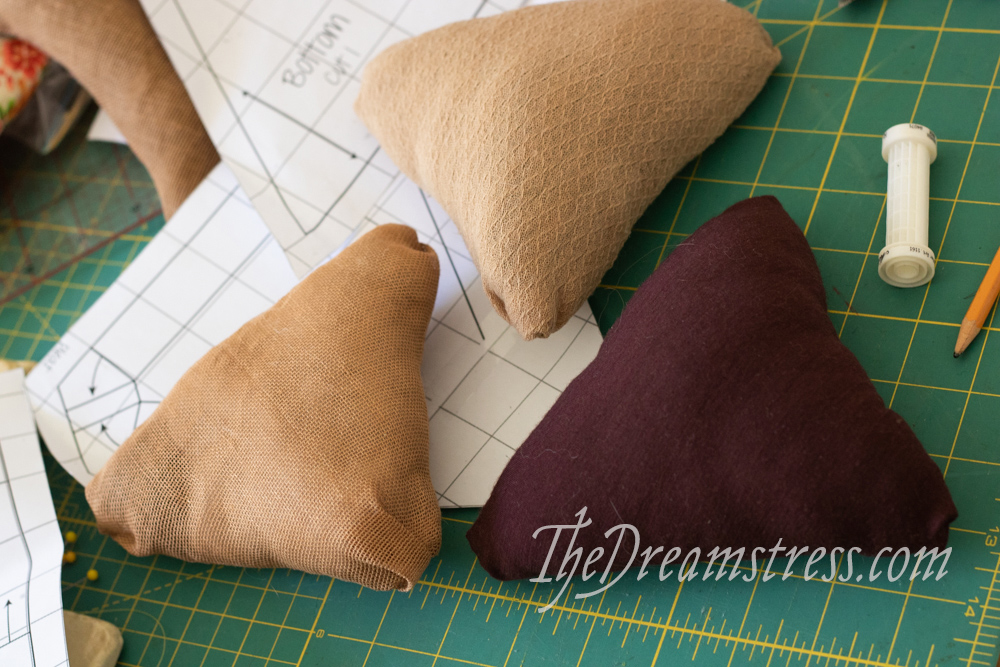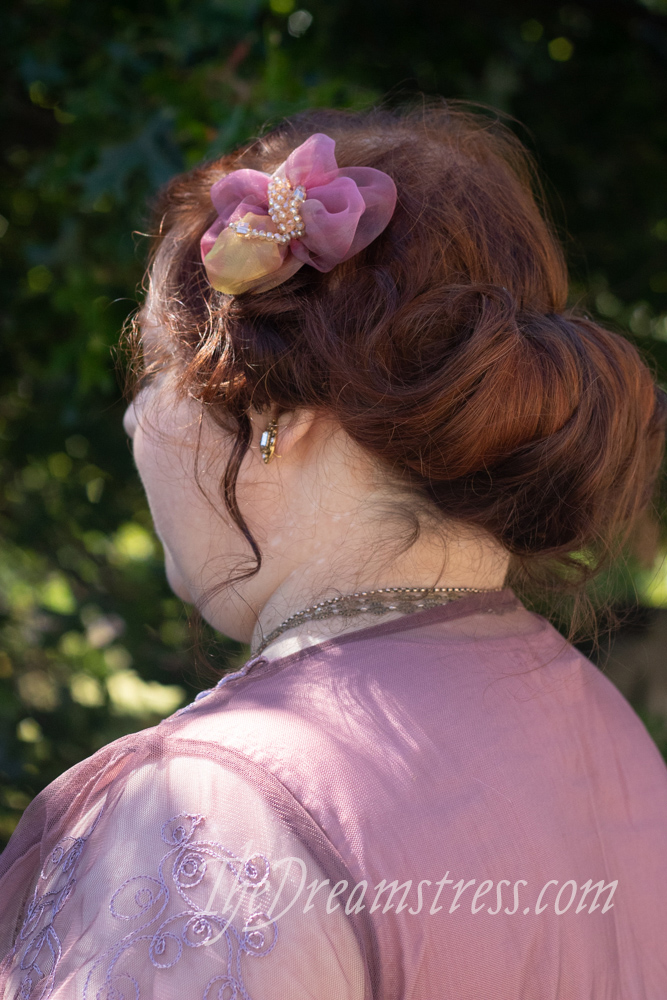After years of making do with bun rolls, and bumpits, and pads made from old hairpieces, and ad-hoc hair supports made from stockings, I’ve really gotten into historical hair-pad making in the last 8 months.
I’ve been experimenting with different patterns for 18th century and Edwardian hair pads (or ‘rats’, as they were called in the late 19th and early 20th century), and using different stuffings and outer fabrics.

Patterns
For 18th century patterns, I’ve mainly been using the American Duchess book, and adjusting the size, shape, and pleat arrangements to get different effects.

I’ve made the 1760s/early 70s ‘banana’ in two slightly different shapes/lengths:

And the early 1780s ‘grub’:

And the later 1780s ‘arrowhead’:

My Edwardian hairpieces are extremely simple. Tubes in different lengths, with rounded ends:

Fabrics:
I’ve tried three different fabrics: a true leno weave cotton gauze (lower left), slightly textured wool knit (upper) and fine merino knit (lower right in dark grape).

The leno weave is by far my favourite: it’s easy to pin into, and the texture helps it to grip to hair and stay in place. The textured knit also works well, although it’s slightly harder to pin into. The merino, while it looks closest to the fabric used in the AD book, has been the least successful. It’s very tricky to pin into, and slips all over the place.
I’m very happy with the leno as an Edwardian-appropriate ‘rat’ fabric, but am not sure if it’s right for the 18th century. I’m planning on experimenting with a woven wool fabric, and perhaps a linen, for future 18th century pads. Wovens rather than knits seem more plausible in the 18th c, and a woven wool would certainly be more durable than a knit with lots of use and pinning.
Stuffings:
This is where things get…interesting.
For half my hair cushions I’ve used wool roving:

And for the others, I’ve used my own hair.
Yep.
It’s absolutely historically accurate. Using your own hair to stuff rats is documented throughout the 19th and early 20th century, and was almost certainly done in the 18th century as well. Why wouldn’t women use it? It’s free, it happens naturally, and using your hair to make it look like you have more hair just makes sense.
I collect mine off my hairbrush every day, and when I have enough I wash it just like you would wash your hair: warm water, shampoo, a bit of friction, and then dry. It tangles and felts, but that’s fine for hairpieces.

I’d use it for all my hairpieces, but I often end up dressing other peoples hair, and it’s nice to have hairpads to lend them that aren’t actually my hair (though why sheep’s hair is fine, but your own is weird, doesn’t really make logical sense).
Wool rovings do have the advantage of being less likely to work their way through the covers. Hair hairpieces can end up being a little…hairy.
These three are all wool.

I also want to try granulated cork and horsehair stuffings. I used all I’d got for testing the Frances Rump, and am having trouble sourcing more with Covid and shipping delays.
The Pads in Action:
Both Jenni & Elisabeth got a little extra height with the ‘Arrowheads’ for the Amalia Jacket photoshoot.


As did I with my witchy chemise hairdo:

The American Duchess 18th Century Beauty book, and Kendra of Demode’s ’18th Century Hair and Wig Styling’ (which is due to be re-published very soon!!!) both have great tutorials for using pads and styling your hair. I’ve combine their techniques depending on time constraints and how historically accurate I want to be.
I just used one of the Edwardian rats to give my friend Emily’s fine, delicate hair some volume for an Edwardian photoshoot:


Natalie has a great tutorial on making and using Edwardian hairpieces on her blog: A Frolic Through Time. She uses a slightly different technique than I do to make her hairpieces, but both work beautifully.
And finally, I made the ones filled with hair first, and they were my entry for:
The HSM 2020 June Challenge ‘It’s Only Natural’

What the item is: three (banana, grub and arrowhead) 1780s hair-filled hair pads
How it fits the challenge: The cotton leno weave is dyed with natural dyes (tea) to match my hair colour, the wool knit is wool, and all three are filled with my hair (which is definitely unexpected in this day and age!)
Material: cotton leno weave, wool knit.
Pattern: the American Duchess 18th c Dressmaking book, and period sources.
Year: ca. 1770, 1780, 1785
Notions: cotton thread, hair.
How historically accurate is it? I’m not at all sure about the fabrics, and human hair as a pad filling isn’t fully documented in the 18th century (as far as I’m aware – mentions don’t make it clear if it’s horse or human hair), although it’s extremely likely.
Hours to complete: about 2 – most of it drawing out the patterns 🤣
First worn: October 31 (arrowhead pad).
Total cost: $1 or less – the fabric was all scraps.
But wait, there’s more! I even made carry bags for both sets of hair pads:

Hot pink for hair, and white for wool, naturally!

Some day I’ll have enough to need 18th c bags, and Edwardian bags. Guess I’ll need some 18th c themed fabric too!


What I’d like to see is a tutorial on actually USING the rats and historical hairstyling. I have very LONG hair, but it is fine and board straight – you can’t SCARE my hair into curling. So, having an idea of how to integrate the rats and correct hair styles (and how to DO them) would be wonderful!
Trip down memory lane for me (mid-20th century). My great aunt (who was born in the 19th century, however) had a china box shaped thing on her dressing table that she called a “hair receiver” that she put her hair into when she cleaned her brush at night. I was thrilled when she put my hair in after brushing it, although she was an agonizingly rigorous hair brusher and braider – I remember feeling like my eyes wouldn’t close after she did my braids! She said that with my curly hair it needed to be braided tightly to be controlled. No idea what happened to the hair in the receiver once it got full; don’t recall her using any kind of a pad to expand her habitual “pleat” at the back of her head. I do remember that her hair when down was very long).
ceci
I have exactly that – a circular Wedgwood china box that I collect hair into daily! It goes from there into a larger container monthly and eventually into hairpieces. If memory serves it was my mother who years ago suggested the practice although she may have meant it jokingly. She always kept her hair 1950’s short and never understood my liking for long hair. She did have a great-aunt though who had been a lady’s maid in a noble house during the Victorian and Edwardian era and she had all these little bits of insight into “the way they used to do things”, that Aunt Peggy had told her about.
this is very helpful to see—i had been pondering the making of some rats to assist with period hairstyles, and i always planned to use my own collected hair. i have rather a lot of hair naturally, and it’s knee-length, but i feel having some structural supports may be necessary to achieve a true period look, especially for certain time frames. not to mention as a base for those HATS. (hello, edwardian and rococo!)…
two questions, if you happen to have time and inclination:
what kind of hairpins do you find best for securing rats/hair together?
i have read victorian and edwardian advertisements for hairpieces, including rats/pads, that came in different shades of human hair. presumably many home-made ones using the owner’s hair were similar. the implication was that the hair wrapped the exterior of the padding or comprised the entire thing (perhaps sort of felted through friction/wrapping?) are you aware of this type, as well as actual stuffed fabric pads? or am i misinterpreting something?
i seem to have a dim recollection from very early childhood of a great-aunt using her collected hair to augment her hairstyle by simply balling it up in her palms, rolling it around a bit into a sausage shape, and then doing something like pinning it as a bun or roll base…it all looked like magic to me at age four.
thanks for this post!
Forgive me if this is an ignorant question, but since knitted stockings existed in the 18thC, might they not have used old stockings to make the casing for hair-pieces? (Which….came out sounding oddly like sausages, oh dear…rats, bananas, grubs, and sausages….)
Just amazing. Love your blog and these glimpses into women’s history. Thanks for taking the time to share
Yes, but are they Snookie Bump-it approved?
In all, I think that it is marvelous to read about your projects, and to read the comments that give small remembered windows into the past.
A lovely post. It was common for women in Victorian times to keep the hair from their brushes to make these. I remember seeing a picture of a hair pot somewhere but can’t remember when, there’s probably some on the web. I would think merino will felt quickly and if you wash it will definitely felt, it’s the best fibre for felting. I don’t think your own hair will felt just tangle so it looks felted, but that would look better.
Haha, I love the touch of the organizational bags. It’s fun to see the shapes and materials you used.
My most used Edwardian rat is made from one leg of an old pair of tights. It’s long enough to wrap most of the way around my head… perfect for the giant, round, donut hair shape! 🙂 The tights are not the easiest thing to pin through with bobby pins, which is what I usually use, but I bet if I used hair pins I would have no problem. (Ha! I’ll have to do that someday…)
For other shapes, I usually use the hair attached to my head (there’s so much of it and the curls usually have no trouble being voluminous) or I have one of those plastic mesh donuts that I’ve cut so that it lays flat. I can fold it into any shape I want and I find that’s useful as well, for things like the base of 1830s side curls.
Anyway… I enjoyed your post and appreciate your question about why your hair feels weird to others but things like wool do not. 🙂
Best,
Quinn
Dear Leimomi,
So glad you found my tutorial helpful! Have used those rats over and over, even reshaping them for moderate lift in early 1770s conservative looks. They’re pretty malleable.
Some of the Edwardian newspaper articles referenced and linked below the tutorial itself have tips and tutorials too, although process illustrations and photos are sparse. Readers trying Edwardian and teen costumes may find these really helpful.
Very best from far-away Kentucky,
Natalie